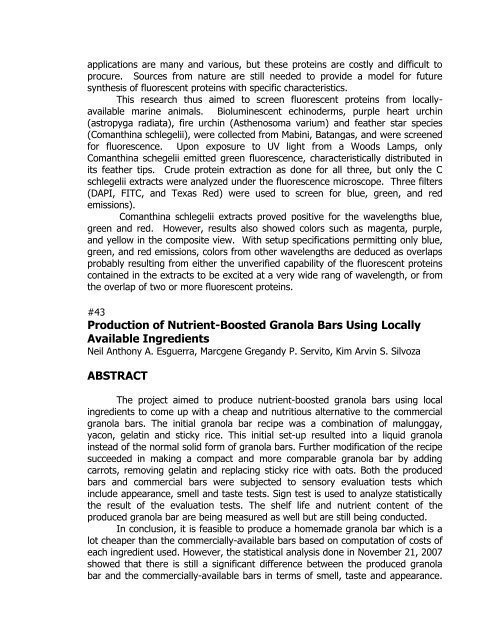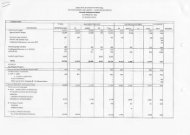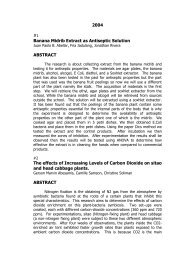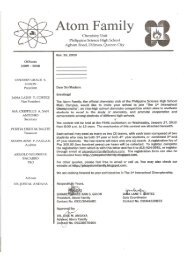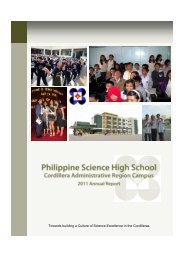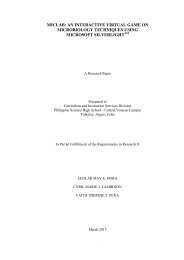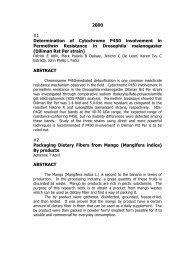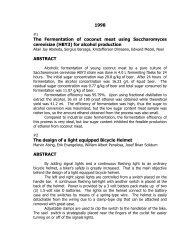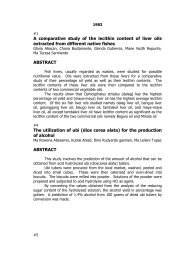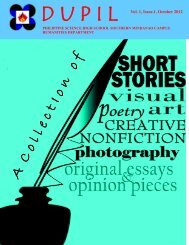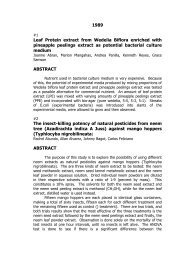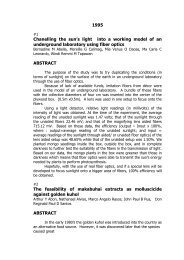2008 Analysis of the Geometry of Drilled Holes in Demolition ...
2008 Analysis of the Geometry of Drilled Holes in Demolition ...
2008 Analysis of the Geometry of Drilled Holes in Demolition ...
You also want an ePaper? Increase the reach of your titles
YUMPU automatically turns print PDFs into web optimized ePapers that Google loves.
applications are many and various, but <strong>the</strong>se prote<strong>in</strong>s are costly and difficult to<br />
procure. Sources from nature are still needed to provide a model for future<br />
syn<strong>the</strong>sis <strong>of</strong> fluorescent prote<strong>in</strong>s with specific characteristics.<br />
This research thus aimed to screen fluorescent prote<strong>in</strong>s from locallyavailable<br />
mar<strong>in</strong>e animals. Biolum<strong>in</strong>escent ech<strong>in</strong>oderms, purple heart urch<strong>in</strong><br />
(astropyga radiata), fire urch<strong>in</strong> (As<strong>the</strong>nosoma varium) and fea<strong>the</strong>r star species<br />
(Comanth<strong>in</strong>a schlegelii), were collected from Mab<strong>in</strong>i, Batangas, and were screened<br />
for fluorescence. Upon exposure to UV light from a Woods Lamps, only<br />
Comanth<strong>in</strong>a schegelii emitted green fluorescence, characteristically distributed <strong>in</strong><br />
its fea<strong>the</strong>r tips. Crude prote<strong>in</strong> extraction as done for all three, but only <strong>the</strong> C<br />
schlegelii extracts were analyzed under <strong>the</strong> fluorescence microscope. Three filters<br />
(DAPI, FITC, and Texas Red) were used to screen for blue, green, and red<br />
emissions).<br />
Comanth<strong>in</strong>a schlegelii extracts proved positive for <strong>the</strong> wavelengths blue,<br />
green and red. However, results also showed colors such as magenta, purple,<br />
and yellow <strong>in</strong> <strong>the</strong> composite view. With setup specifications permitt<strong>in</strong>g only blue,<br />
green, and red emissions, colors from o<strong>the</strong>r wavelengths are deduced as overlaps<br />
probably result<strong>in</strong>g from ei<strong>the</strong>r <strong>the</strong> unverified capability <strong>of</strong> <strong>the</strong> fluorescent prote<strong>in</strong>s<br />
conta<strong>in</strong>ed <strong>in</strong> <strong>the</strong> extracts to be excited at a very wide rang <strong>of</strong> wavelength, or from<br />
<strong>the</strong> overlap <strong>of</strong> two or more fluorescent prote<strong>in</strong>s.<br />
#43<br />
Production <strong>of</strong> Nutrient-Boosted Granola Bars Us<strong>in</strong>g Locally<br />
Available Ingredients<br />
Neil Anthony A. Esguerra, Marcgene Gregandy P. Servito, Kim Arv<strong>in</strong> S. Silvoza<br />
ABSTRACT<br />
The project aimed to produce nutrient-boosted granola bars us<strong>in</strong>g local<br />
<strong>in</strong>gredients to come up with a cheap and nutritious alternative to <strong>the</strong> commercial<br />
granola bars. The <strong>in</strong>itial granola bar recipe was a comb<strong>in</strong>ation <strong>of</strong> malunggay,<br />
yacon, gelat<strong>in</strong> and sticky rice. This <strong>in</strong>itial set-up resulted <strong>in</strong>to a liquid granola<br />
<strong>in</strong>stead <strong>of</strong> <strong>the</strong> normal solid form <strong>of</strong> granola bars. Fur<strong>the</strong>r modification <strong>of</strong> <strong>the</strong> recipe<br />
succeeded <strong>in</strong> mak<strong>in</strong>g a compact and more comparable granola bar by add<strong>in</strong>g<br />
carrots, remov<strong>in</strong>g gelat<strong>in</strong> and replac<strong>in</strong>g sticky rice with oats. Both <strong>the</strong> produced<br />
bars and commercial bars were subjected to sensory evaluation tests which<br />
<strong>in</strong>clude appearance, smell and taste tests. Sign test is used to analyze statistically<br />
<strong>the</strong> result <strong>of</strong> <strong>the</strong> evaluation tests. The shelf life and nutrient content <strong>of</strong> <strong>the</strong><br />
produced granola bar are be<strong>in</strong>g measured as well but are still be<strong>in</strong>g conducted.<br />
In conclusion, it is feasible to produce a homemade granola bar which is a<br />
lot cheaper than <strong>the</strong> commercially-available bars based on computation <strong>of</strong> costs <strong>of</strong><br />
each <strong>in</strong>gredient used. However, <strong>the</strong> statistical analysis done <strong>in</strong> November 21, 2007<br />
showed that <strong>the</strong>re is still a significant difference between <strong>the</strong> produced granola<br />
bar and <strong>the</strong> commercially-available bars <strong>in</strong> terms <strong>of</strong> smell, taste and appearance.


